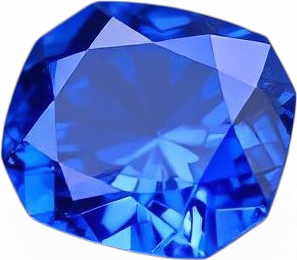In 1934 when Princess Marina of Greece and Denmark, granddaughter of George I of Greece and great granddaughter of Tsar Alexander II of Russia married Prince George of Kent, the 4th son of George V and Queen Mary of the United Kingdom, her mother-in-law gave her the beautiful Cambridge Sapphire Parure, a family heirloom that was made for Queen Mary's grandmother, Princess Augusta, Duchess of Cambridge, who left the jewels to her daughter, Grand Duchess Augusta of Mecklenburg-Strelitz, Queen Mary’s aunt. In 1916, the aunt willed her sapphire parsue to her favorite niece, Queen Mary, who presented the set to her new daughter-in-law.
 |
The tiara could also be worn as a necklace. |
A parure is a set of jewelry that is meant to be worn together. Princess Marina received a tiara, a necklace, 2 bracelets, 2 brooches, earrings, and a corsage jewel. I’ve combed the internet for photos to show the jewelry, most of the images were taken in black and white or later in life as Princess Marina wore her Cambridge Sapphire Parure for decades to carnations and state dinners.

When Princess Marina died in 1968 she left the Cambridge Sapphire Parure to her daughter-in-law, Katharine, the new Duchess of Kent, who in 1961 had married Prince Edward, Marina’s eldest son.
Unfortunately as time passed, the Kents couldn’t afford to keep the parure in tact. Some of its stones were sold and eventually all of its pieces disappeared from public view, presumed auctioned and bought by private collectors. It’s sad to see these historic pieces broken up and not end up in a museum.
₊˚💎𖥔 ݁ ˖ ✦ ‧₊˚ 💠 𖥔 ݁ ˖ ✦ ₊˚ 💎𖥔 ݁ ˖ ✦ ₊˚
Ordinary people could never afford such magnificent pieces of jewelry consisting of a set of so many heirloom quality sapphires. Also, we never attend royal galas, so where could we wear them? A Trip to Walmart, down in the subway, or a TIME magazine pour?
Savvy Shoppers on a budget settle for commercial grade smaller stones but honestly can easily enjoy them just as much. Inspired by the Cambridge Sapphire Parsure, I picked a few lovely pieces sold by Macy’s, Belk, Saks and other department stores to illustrate how much we can love lesser pieces of jewelry! Each department store offers a wider selection to match every taste, and they run frequent sales making a jewelry splurge more affordable to an average Debra, um Jane!😛Tips: If you do splurge on jewelry never pick pieces so fancy they stay in a box most of the year. Don’t be afraid of lab-grown stones either. Lab-grown gemstones are physically, chemically, and optically the same as natural gemstones, but cheaper. People will pay more for natural gemstones, yet jewelry is never an investment. You will rarely make a profit by selling your jewelry. Find classic pieces within your budget that you can pair with a little black dress, as well as, blue jeans. When jewelry stays in a box, it's a complete waste of money -- a splurge gone wrong!👑
Be sure to visit Tiffany, as well as, the gemstone wings of the Natural History Museum in New York and the Smithsonian in Washington, D.C. to see the heirloom gemstones when you're in the towns, and Macy’s Herald Square for the commercial grade sparklers. Also, inexperienced buyers are more apt to get taken than to score a good deal in NYC's diamond district. The vibe is to sell and it's not much fun to browse there.
You may also enjoy:








































